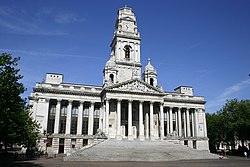Portsmouth Guildhall
| Portsmouth Guildhall | |
|
Hampshire | |
|---|---|

| |
| Type: | Concert hall |
| Location | |
| Grid reference: | SU64020019 |
| Location: | 50°47’52"N, 1°5’34"W |
| City: | Portsmouth |
| History | |
| Built 1890 | |
| By: | William Hill |
| Concert hall | |
| Neo-classical | |
| Information | |
| Website: | http://portsmouthguildhall.org.uk/ |
Portsmouth Guildhall is a multi-use venue in the centre of Portsmouth, Hampshire, located on a pedestrian square close to the Portsmouth and Southsea railway station. Constructed in 1890 and originally used by the local council, the building was known as Portsmouth Town Hall until 1926. It was heavily damaged by bombing during the Second World War and largely rebuilt during the 1950s. Today it operates as a concert, wedding and conference venue.
History

The building was designed in the neo-classical style by architect William Hill, who had previously designed the visually similar Bolton Town Hall. Local architect Charles Bevis, in partnership with Hill, directed the construction. Hill died before the building was completed and Bevis added to the design.
When completed in 1890, the building became the civic town hall.[1] On 21 April 1926 Portsmouth was raised to the status of a city and the Town Hall was simultaneously renamed the Guildhall.
On 10 January 1941, during the Second World War, it was hit by enemy incendiary bombs. The resultant fire gutted the building, completely destroying the interior and roof. Just the outer walls and tower remained standing, and those were fire-damaged. The Guildhall was rebuilt after the war at a cost of £1.5 million, using war compensation funds. The interior was altered from the original and the external style is missing much of its original detail, especially the dome above the clock and the finials atop the balustrades around the roof. Elizabeth II re-opened the building in a ceremony on 8 June 1959.
Bells

There are five bells in its bell tower known as the Pompey Chimes. The biggest bell is named after Queen Victoria and is inscribed with her name.[2] The remaining four were named by public poll and Nelson, Victory and John Pounds[3] The official naming was stalled due to the popularity of the vote for Harry Redknapp,[4] the former Portsmouth Football Club manager who departed the club shortly before voting commenced. Foul play was suspected by the council who ran the vote and the bells have remained unnamed.[5]
The Pompey Chimes fell silent in 2003 when the bell tower was found to be in need of restoration from the corrosive nature of salt in the air.[6] The work was carried out by Smith of Derby Group, the restoration project finishing in time for Queen Elizabeth's visit to Portsmouth in 2009 to mark the 65th anniversary of the D-Day landings.[7]
Current use

The Guildhall now operates as a concert, wedding and conference venue. It has been managed by the Portsmouth Cultural Trust, a registered charity, since 2011.[8]
The main hall has a standing capacity of up to 2,500 for concerts,[9] whilst other rooms can accommodate up to 500 people for weddings or banquets. Facilities include a café, art galleries, meeting rooms and a business lounge.
References
- ↑ Portsmouth Guide website: Portsmouth Guildhall History
- ↑ Portsmouth News website: Pompey Chimes back where they belong!
- ↑ BBC website: The Queen's visit to Portsmouth in 2009
- ↑ Portsmouth News website: Bell Name Poll Chimes a Low Note with Council
- ↑ Portsmouth News website: Chimes Stay Unnamed Because Harry's In The Frame
- ↑ Smith of Derby website: Portsmouth Guildhall Bell Tower case study
- ↑ BBC website: The Queen's visit to Portsmouth in 2009
- ↑ "Portsmouth Cultural Trust". http://www.portsmouthguildhall.org.uk/about-us/portsmouth-cultural-trust. Retrieved 25 March 2015.
- ↑ Portsmouth Guildhall official website. Retrieved 3 December 2014
Outside links
| ("Wikimedia Commons" has material about Portsmouth Guildhall) |